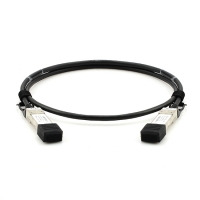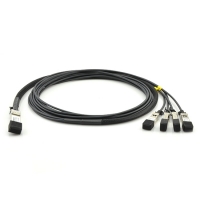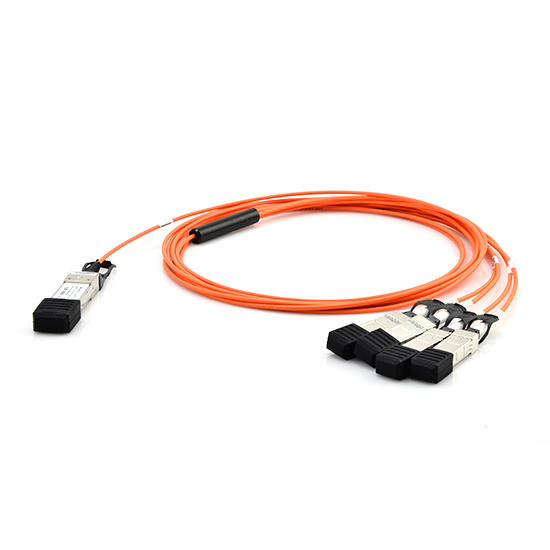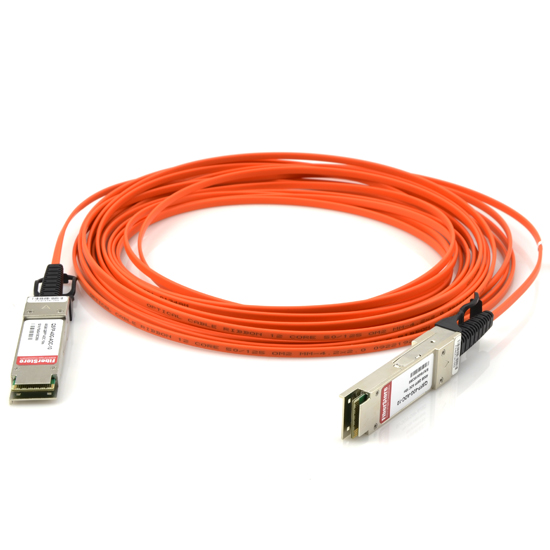There are two 40 Gigabit fibre optic physical medium dependent (PMD) specifications in the standard, which provide 40 Gb/s Ethernet over multimode fibre (MMF) optic cable and single mode fibre (SMF) optic cable. The 40GBase-SR4 short reach fibre optic system sends four lanes of PCS data over four pairs of multimode cables, for a total of eight fibre strands. The 40GBase-LR long-reach system sends four lanes of PCS data four wavelengths of light, carried over a single pair of fibre optic cables.
The first 40 Gb/s transceivers were based on the C form-factor pluggable (CFP) module, 40G CFP transceiver which is a large module capable of handling up to 24 watts of power requirements were based on this module. The CFP modules is specified by a multiagreement.
CFP module, which can be used to provide either a 40GBase-SR4 or a 40GBase-LR4 transceiver. The module is a 40 GBase-LR4 connection is described. The most popular connector for 40 Gb/s interfaces these days is the QSFP+ module: it takes up much less space on a switch or server interface, making it possible for vendors to provide multiple QSFP+ transceiver module for 40GBase-SR4 is provided with a multifibre push-on (MPO) media connector, carrying multiple pairs of fibre optic cables to support the four lanes of data for the short reach fibre standard. The 40GBase-LR4 long-reach system uses a QSFP+ transceiver equipped with a duplex fibre connector for connecting to the single pair of fibre cables.
Recently Molex Incorporated, the world’s largest plug-in companies introduced the QSFP+ interconnect solution designed for a multimode of markets and applications including switches, router, Host Bus Adapters (HBAs), enterprise data centres. high-performance computing (HPC) and storage. Components of the system include the Electromagnetic Interference (EMI) shielding cage, passive cable assembly, active cable assembly, optical MTP cable assembly, optical QSFP+ loopback, and a 38-circuit SMT iPass host connector.
“The QSFP has evolved to QSFP+ to meet 40Gbps data rates just as SFP progressed from SFP to SFP+ for 40 Gbps rates. The original QSFP MSA now resides as INF-8438 and is no longer an appropriate designation for use, being superseded by SFF-8436 in the SFF Committee,” said Jay Neer, advanced technical market manager, industry standards, Molex Incorporatd.
QSFP+ uses a standard 38-circuit iPass SMT host connector with a proven mating interface that connector with a proven mating interface that enables high durability. The iPass SMT host connector with a proven mating interface that enable high durability. The iPass contact design, also implemented in other standards such as PCIe, SAS, SATA, Ethernet and InfiniBand, provides four balanced differential channels featuring class-leading isolation, and bandwidth, with durability cycling up to 250 cycles. The Molex host connector mounts to the PCB beneath a low-profile metal cage that provide latch points and is engineered to provide appropriate EMI protection for the host system port. Optional light pipes and heat sink thermal solutions can be slipped onto the cage when needed.
The QSFP+ cables assemblies are designed to accommodate stacked and ganged connector configurations in extremely high density requirements. They support 40G Ethernet, InfiniBand, SAS and SONET/SDH standards with different data rate options.
The optical QSFP+ MTP cable assemblies and loopbacks meet the QSFP+ interface specification. Cables are constructed with 12-fibre 3.00mm round cable for data centre interconnect cable assembly applications.
The round cable provides much improved cable management over the traditional flat ribbon cable. A robust 4.50mm round optical cable ensure cable integrity and improved cable routing for installations that require connections greater than 25m apart.
QSFP+ breakout cable assemblies are available for SFP+ or patch panel installations. Loopbacks feature a compact housing compatible with module spacing and loop optical transmit ports to receive ports for testing, burn -in, and field troubleshoot.
The related products what mentioned above all can be offered from FS.COM, at the same time, I need to tell you good news that some optical fibre products are working with 30% of the price discount now. Welcome to visit our online store.


 QSFP-4SFP10G-CU series products are compatible for Cisco 40GBASE-CR4 QSFP to 4 10GBASE-CU SFP+ direct attach cable, 0.5- 5 metres, passive solution. Fiberstore QSFP+ to four SFP+ copper direct-attach breakout cables are suitable for very short distances and offer a highly cost-effective way to connect within racks and across adjacent racks. These breakout cables connect to a 40G QSFP+ port of a Cisco switch on one end and to four 10G SFP+ ports of a Cisco switch on the other end. Our passive cables in lengths of 0.5, 1, 2, 3, 4 and 5 metres.
QSFP-4SFP10G-CU series products are compatible for Cisco 40GBASE-CR4 QSFP to 4 10GBASE-CU SFP+ direct attach cable, 0.5- 5 metres, passive solution. Fiberstore QSFP+ to four SFP+ copper direct-attach breakout cables are suitable for very short distances and offer a highly cost-effective way to connect within racks and across adjacent racks. These breakout cables connect to a 40G QSFP+ port of a Cisco switch on one end and to four 10G SFP+ ports of a Cisco switch on the other end. Our passive cables in lengths of 0.5, 1, 2, 3, 4 and 5 metres.



